Diploma of IT: BSBSUS501 Unit Knowledge Test - Sustainability
VerifiedAdded on 2022/09/14
|18
|4000
|13
Homework Assignment
AI Summary
This document provides a comprehensive solution to the BSBSUS501 Unit Knowledge Test, focusing on developing workplace policies and procedures for sustainability. It covers key aspects such as the importance of sustainability policies, the steps involved in policy development, and potential barriers to implementation. The solution explores the relationship between organizational processes and sustainability, identifying stakeholders and their contributions to policy-making. It further examines strategies for promoting workplace sustainability, stakeholder communication methods, and the role of tools and systems in monitoring and improving sustainability policies. The document also details strategies for continuous improvement in resource efficiency, factors for implementing sustainability policies, and the assignment of responsibilities. It includes information on different types of reports, the importance of policy progress investigation, and the significance of monitoring records. Finally, it discusses policy modification, knowledge assessment, stakeholder interests, recommendations, and the knowledge required for developing policies and procedures. The document is a valuable resource for students studying sustainability and business development.
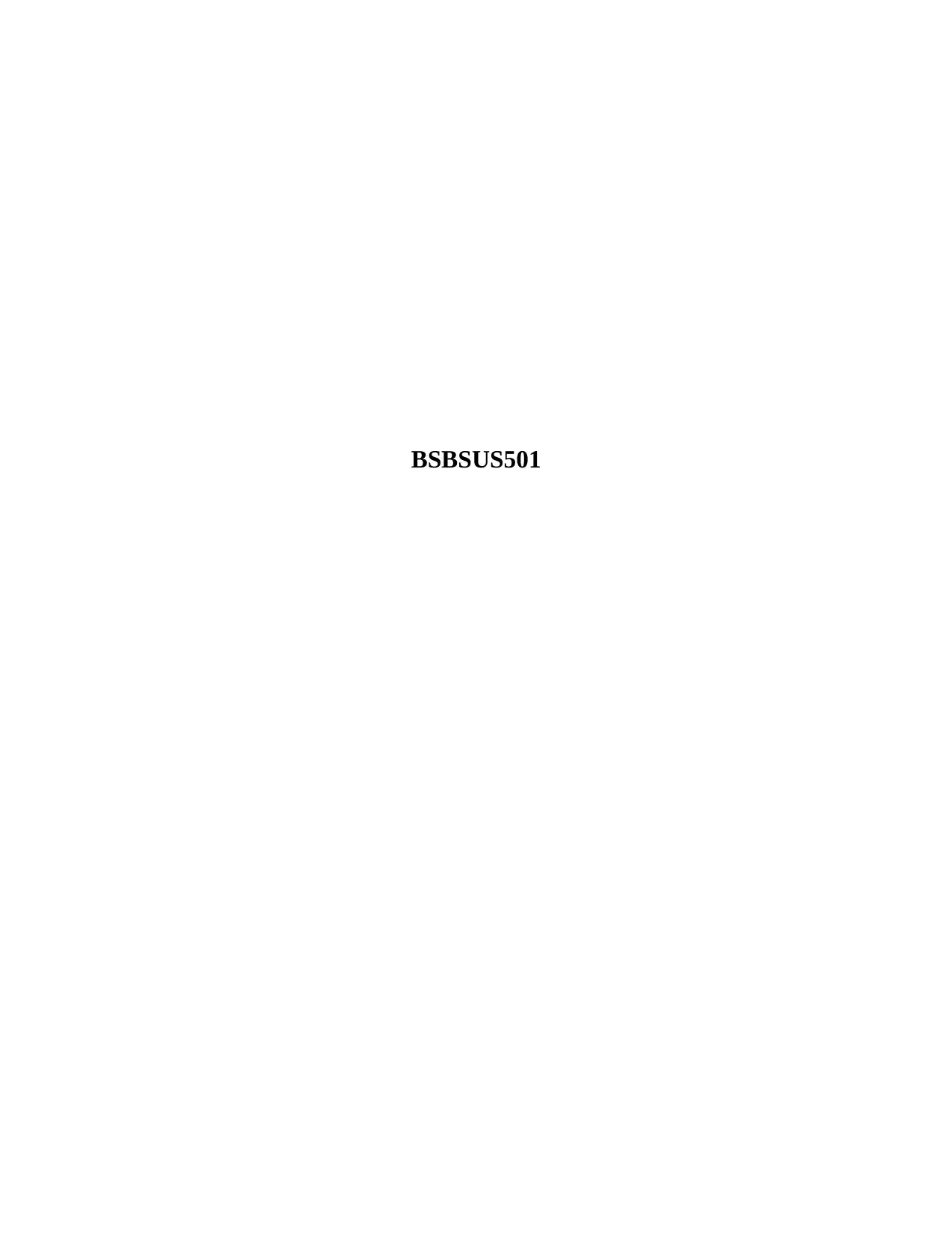
BSBSUS501
Paraphrase This Document
Need a fresh take? Get an instant paraphrase of this document with our AI Paraphraser
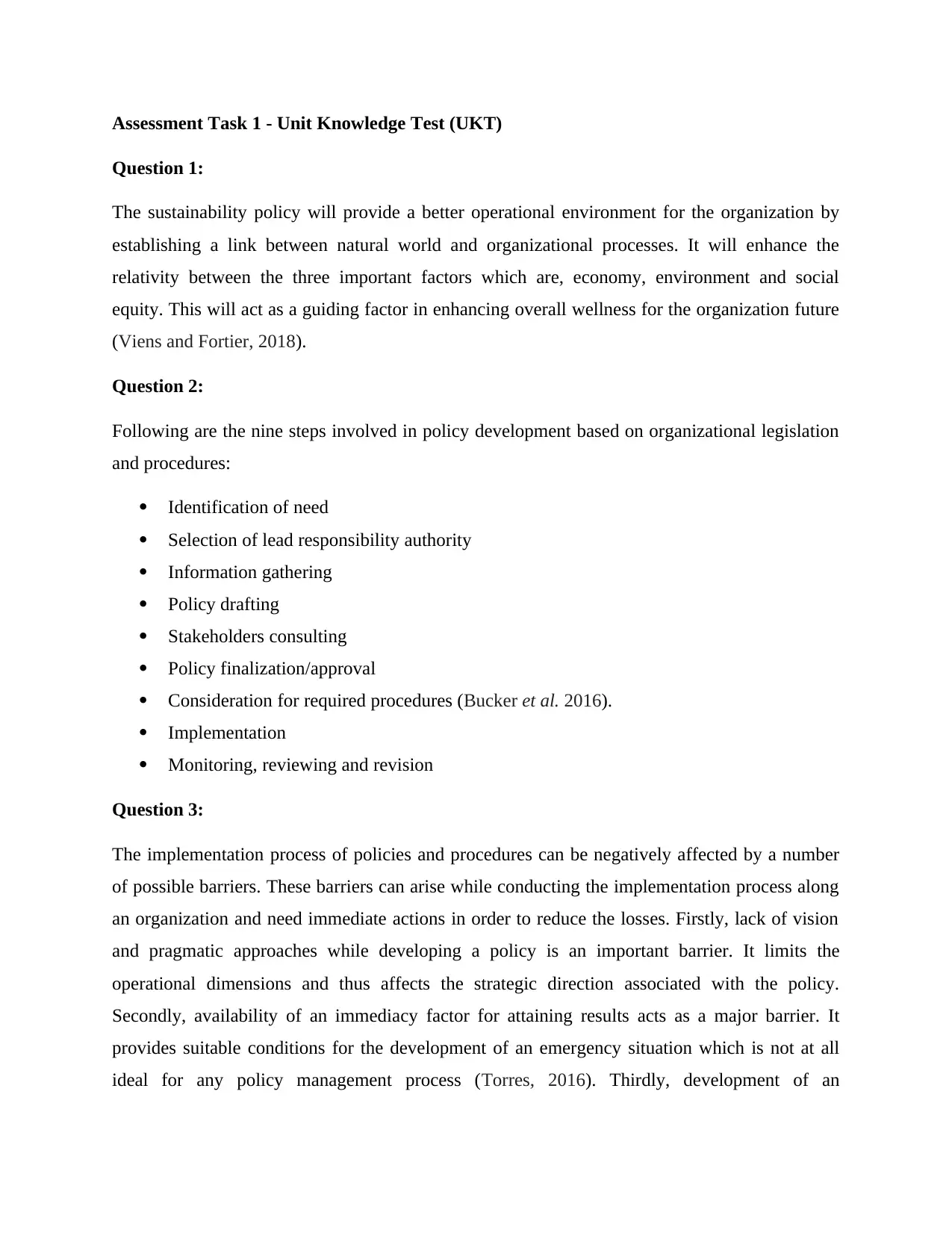
Assessment Task 1 - Unit Knowledge Test (UKT)
Question 1:
The sustainability policy will provide a better operational environment for the organization by
establishing a link between natural world and organizational processes. It will enhance the
relativity between the three important factors which are, economy, environment and social
equity. This will act as a guiding factor in enhancing overall wellness for the organization future
(Viens and Fortier, 2018).
Question 2:
Following are the nine steps involved in policy development based on organizational legislation
and procedures:
Identification of need
Selection of lead responsibility authority
Information gathering
Policy drafting
Stakeholders consulting
Policy finalization/approval
Consideration for required procedures (Bucker et al. 2016).
Implementation
Monitoring, reviewing and revision
Question 3:
The implementation process of policies and procedures can be negatively affected by a number
of possible barriers. These barriers can arise while conducting the implementation process along
an organization and need immediate actions in order to reduce the losses. Firstly, lack of vision
and pragmatic approaches while developing a policy is an important barrier. It limits the
operational dimensions and thus affects the strategic direction associated with the policy.
Secondly, availability of an immediacy factor for attaining results acts as a major barrier. It
provides suitable conditions for the development of an emergency situation which is not at all
ideal for any policy management process (Torres, 2016). Thirdly, development of an
Question 1:
The sustainability policy will provide a better operational environment for the organization by
establishing a link between natural world and organizational processes. It will enhance the
relativity between the three important factors which are, economy, environment and social
equity. This will act as a guiding factor in enhancing overall wellness for the organization future
(Viens and Fortier, 2018).
Question 2:
Following are the nine steps involved in policy development based on organizational legislation
and procedures:
Identification of need
Selection of lead responsibility authority
Information gathering
Policy drafting
Stakeholders consulting
Policy finalization/approval
Consideration for required procedures (Bucker et al. 2016).
Implementation
Monitoring, reviewing and revision
Question 3:
The implementation process of policies and procedures can be negatively affected by a number
of possible barriers. These barriers can arise while conducting the implementation process along
an organization and need immediate actions in order to reduce the losses. Firstly, lack of vision
and pragmatic approaches while developing a policy is an important barrier. It limits the
operational dimensions and thus affects the strategic direction associated with the policy.
Secondly, availability of an immediacy factor for attaining results acts as a major barrier. It
provides suitable conditions for the development of an emergency situation which is not at all
ideal for any policy management process (Torres, 2016). Thirdly, development of an
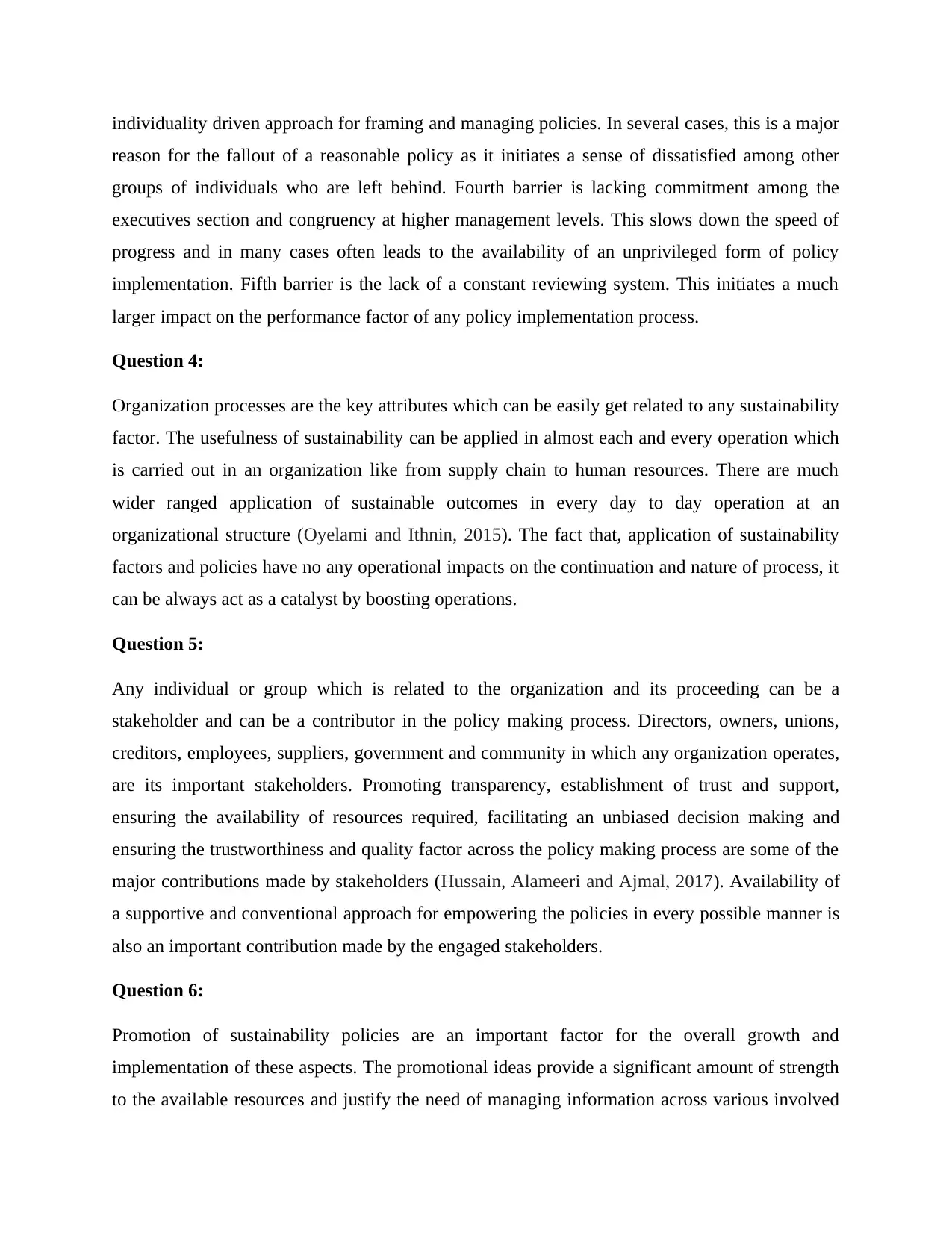
individuality driven approach for framing and managing policies. In several cases, this is a major
reason for the fallout of a reasonable policy as it initiates a sense of dissatisfied among other
groups of individuals who are left behind. Fourth barrier is lacking commitment among the
executives section and congruency at higher management levels. This slows down the speed of
progress and in many cases often leads to the availability of an unprivileged form of policy
implementation. Fifth barrier is the lack of a constant reviewing system. This initiates a much
larger impact on the performance factor of any policy implementation process.
Question 4:
Organization processes are the key attributes which can be easily get related to any sustainability
factor. The usefulness of sustainability can be applied in almost each and every operation which
is carried out in an organization like from supply chain to human resources. There are much
wider ranged application of sustainable outcomes in every day to day operation at an
organizational structure (Oyelami and Ithnin, 2015). The fact that, application of sustainability
factors and policies have no any operational impacts on the continuation and nature of process, it
can be always act as a catalyst by boosting operations.
Question 5:
Any individual or group which is related to the organization and its proceeding can be a
stakeholder and can be a contributor in the policy making process. Directors, owners, unions,
creditors, employees, suppliers, government and community in which any organization operates,
are its important stakeholders. Promoting transparency, establishment of trust and support,
ensuring the availability of resources required, facilitating an unbiased decision making and
ensuring the trustworthiness and quality factor across the policy making process are some of the
major contributions made by stakeholders (Hussain, Alameeri and Ajmal, 2017). Availability of
a supportive and conventional approach for empowering the policies in every possible manner is
also an important contribution made by the engaged stakeholders.
Question 6:
Promotion of sustainability policies are an important factor for the overall growth and
implementation of these aspects. The promotional ideas provide a significant amount of strength
to the available resources and justify the need of managing information across various involved
reason for the fallout of a reasonable policy as it initiates a sense of dissatisfied among other
groups of individuals who are left behind. Fourth barrier is lacking commitment among the
executives section and congruency at higher management levels. This slows down the speed of
progress and in many cases often leads to the availability of an unprivileged form of policy
implementation. Fifth barrier is the lack of a constant reviewing system. This initiates a much
larger impact on the performance factor of any policy implementation process.
Question 4:
Organization processes are the key attributes which can be easily get related to any sustainability
factor. The usefulness of sustainability can be applied in almost each and every operation which
is carried out in an organization like from supply chain to human resources. There are much
wider ranged application of sustainable outcomes in every day to day operation at an
organizational structure (Oyelami and Ithnin, 2015). The fact that, application of sustainability
factors and policies have no any operational impacts on the continuation and nature of process, it
can be always act as a catalyst by boosting operations.
Question 5:
Any individual or group which is related to the organization and its proceeding can be a
stakeholder and can be a contributor in the policy making process. Directors, owners, unions,
creditors, employees, suppliers, government and community in which any organization operates,
are its important stakeholders. Promoting transparency, establishment of trust and support,
ensuring the availability of resources required, facilitating an unbiased decision making and
ensuring the trustworthiness and quality factor across the policy making process are some of the
major contributions made by stakeholders (Hussain, Alameeri and Ajmal, 2017). Availability of
a supportive and conventional approach for empowering the policies in every possible manner is
also an important contribution made by the engaged stakeholders.
Question 6:
Promotion of sustainability policies are an important factor for the overall growth and
implementation of these aspects. The promotional ideas provide a significant amount of strength
to the available resources and justify the need of managing information across various involved
⊘ This is a preview!⊘
Do you want full access?
Subscribe today to unlock all pages.

Trusted by 1+ million students worldwide
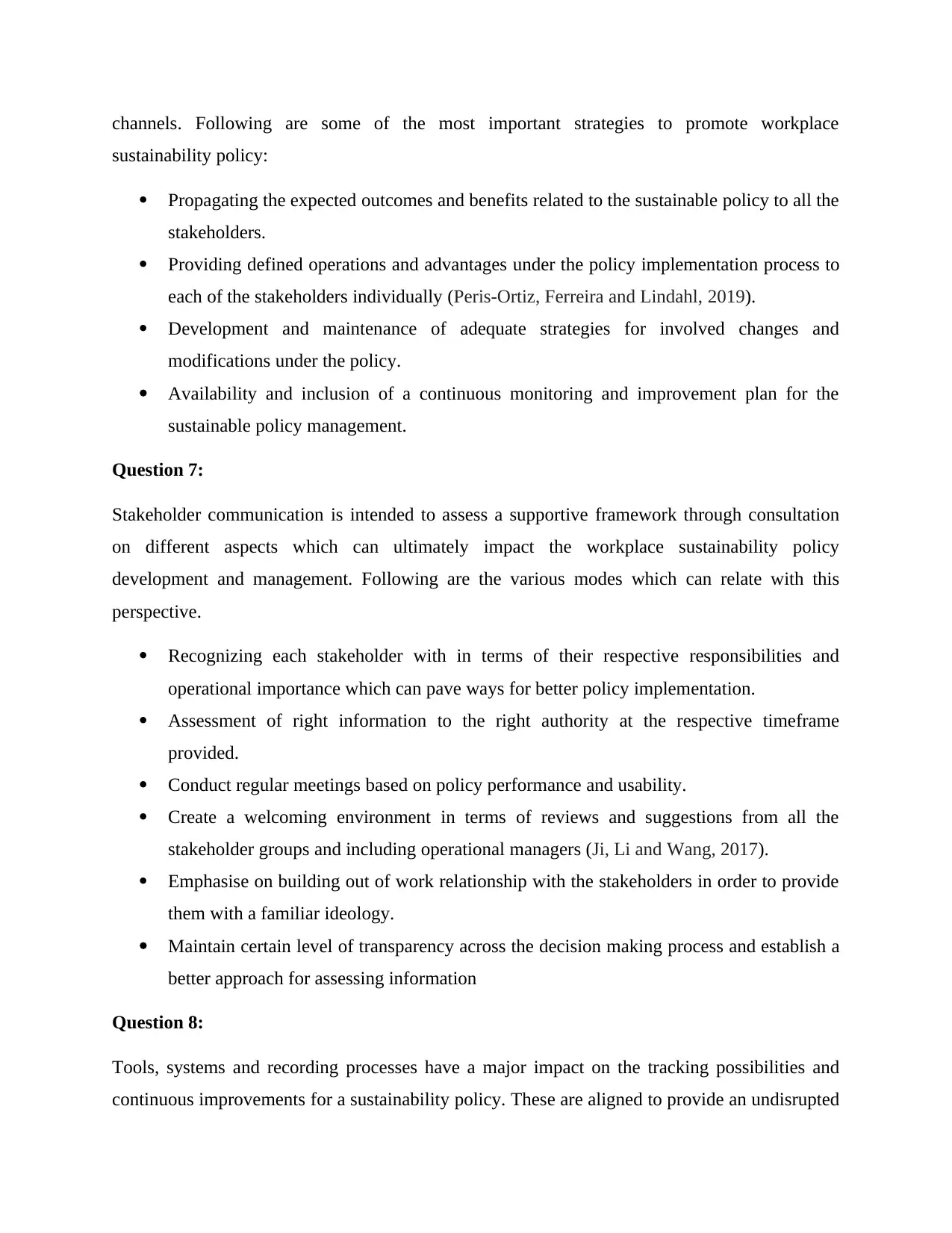
channels. Following are some of the most important strategies to promote workplace
sustainability policy:
Propagating the expected outcomes and benefits related to the sustainable policy to all the
stakeholders.
Providing defined operations and advantages under the policy implementation process to
each of the stakeholders individually (Peris-Ortiz, Ferreira and Lindahl, 2019).
Development and maintenance of adequate strategies for involved changes and
modifications under the policy.
Availability and inclusion of a continuous monitoring and improvement plan for the
sustainable policy management.
Question 7:
Stakeholder communication is intended to assess a supportive framework through consultation
on different aspects which can ultimately impact the workplace sustainability policy
development and management. Following are the various modes which can relate with this
perspective.
Recognizing each stakeholder with in terms of their respective responsibilities and
operational importance which can pave ways for better policy implementation.
Assessment of right information to the right authority at the respective timeframe
provided.
Conduct regular meetings based on policy performance and usability.
Create a welcoming environment in terms of reviews and suggestions from all the
stakeholder groups and including operational managers (Ji, Li and Wang, 2017).
Emphasise on building out of work relationship with the stakeholders in order to provide
them with a familiar ideology.
Maintain certain level of transparency across the decision making process and establish a
better approach for assessing information
Question 8:
Tools, systems and recording processes have a major impact on the tracking possibilities and
continuous improvements for a sustainability policy. These are aligned to provide an undisrupted
sustainability policy:
Propagating the expected outcomes and benefits related to the sustainable policy to all the
stakeholders.
Providing defined operations and advantages under the policy implementation process to
each of the stakeholders individually (Peris-Ortiz, Ferreira and Lindahl, 2019).
Development and maintenance of adequate strategies for involved changes and
modifications under the policy.
Availability and inclusion of a continuous monitoring and improvement plan for the
sustainable policy management.
Question 7:
Stakeholder communication is intended to assess a supportive framework through consultation
on different aspects which can ultimately impact the workplace sustainability policy
development and management. Following are the various modes which can relate with this
perspective.
Recognizing each stakeholder with in terms of their respective responsibilities and
operational importance which can pave ways for better policy implementation.
Assessment of right information to the right authority at the respective timeframe
provided.
Conduct regular meetings based on policy performance and usability.
Create a welcoming environment in terms of reviews and suggestions from all the
stakeholder groups and including operational managers (Ji, Li and Wang, 2017).
Emphasise on building out of work relationship with the stakeholders in order to provide
them with a familiar ideology.
Maintain certain level of transparency across the decision making process and establish a
better approach for assessing information
Question 8:
Tools, systems and recording processes have a major impact on the tracking possibilities and
continuous improvements for a sustainability policy. These are aligned to provide an undisrupted
Paraphrase This Document
Need a fresh take? Get an instant paraphrase of this document with our AI Paraphraser
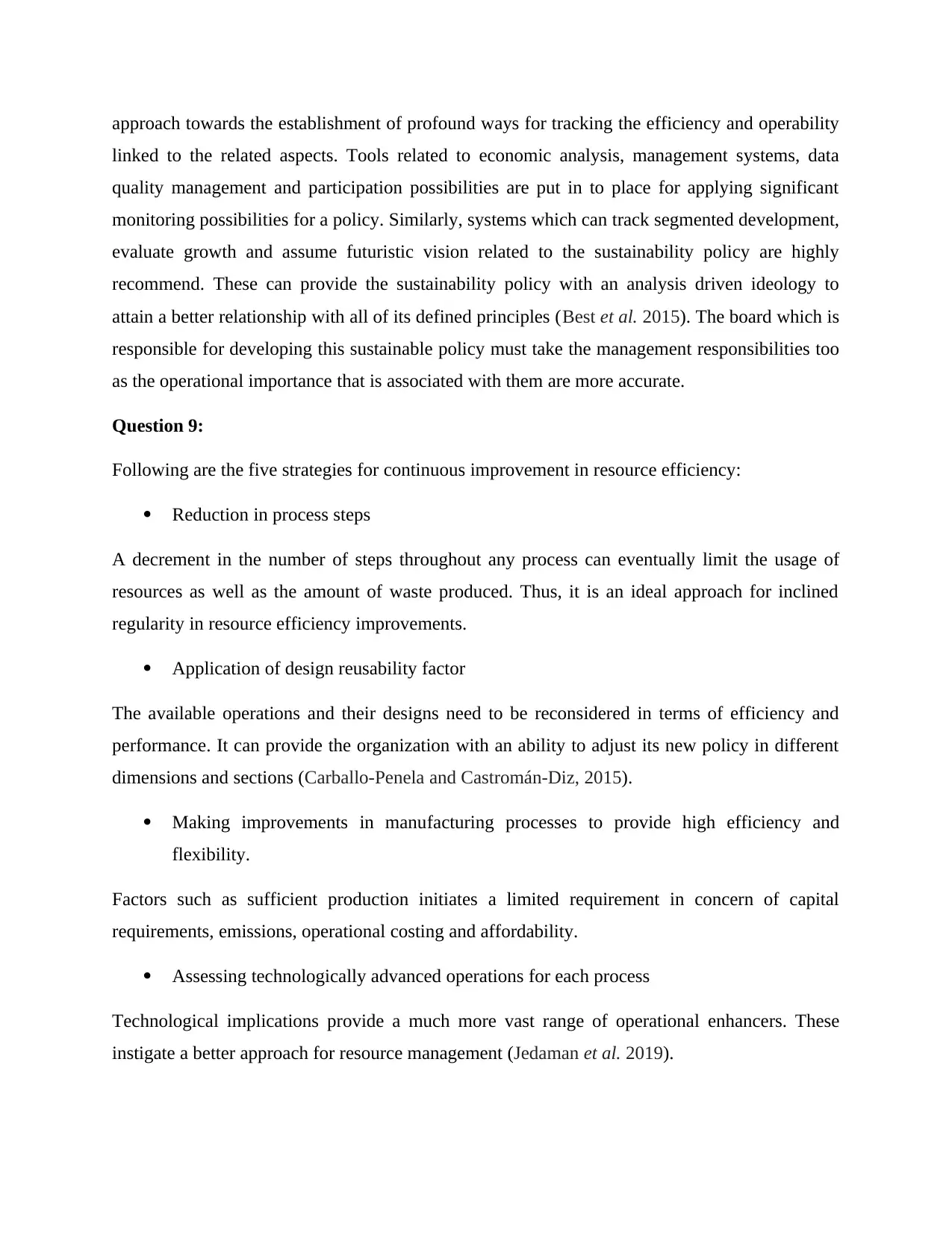
approach towards the establishment of profound ways for tracking the efficiency and operability
linked to the related aspects. Tools related to economic analysis, management systems, data
quality management and participation possibilities are put in to place for applying significant
monitoring possibilities for a policy. Similarly, systems which can track segmented development,
evaluate growth and assume futuristic vision related to the sustainability policy are highly
recommend. These can provide the sustainability policy with an analysis driven ideology to
attain a better relationship with all of its defined principles (Best et al. 2015). The board which is
responsible for developing this sustainable policy must take the management responsibilities too
as the operational importance that is associated with them are more accurate.
Question 9:
Following are the five strategies for continuous improvement in resource efficiency:
Reduction in process steps
A decrement in the number of steps throughout any process can eventually limit the usage of
resources as well as the amount of waste produced. Thus, it is an ideal approach for inclined
regularity in resource efficiency improvements.
Application of design reusability factor
The available operations and their designs need to be reconsidered in terms of efficiency and
performance. It can provide the organization with an ability to adjust its new policy in different
dimensions and sections (Carballo‐Penela and Castromán‐Diz, 2015).
Making improvements in manufacturing processes to provide high efficiency and
flexibility.
Factors such as sufficient production initiates a limited requirement in concern of capital
requirements, emissions, operational costing and affordability.
Assessing technologically advanced operations for each process
Technological implications provide a much more vast range of operational enhancers. These
instigate a better approach for resource management (Jedaman et al. 2019).
linked to the related aspects. Tools related to economic analysis, management systems, data
quality management and participation possibilities are put in to place for applying significant
monitoring possibilities for a policy. Similarly, systems which can track segmented development,
evaluate growth and assume futuristic vision related to the sustainability policy are highly
recommend. These can provide the sustainability policy with an analysis driven ideology to
attain a better relationship with all of its defined principles (Best et al. 2015). The board which is
responsible for developing this sustainable policy must take the management responsibilities too
as the operational importance that is associated with them are more accurate.
Question 9:
Following are the five strategies for continuous improvement in resource efficiency:
Reduction in process steps
A decrement in the number of steps throughout any process can eventually limit the usage of
resources as well as the amount of waste produced. Thus, it is an ideal approach for inclined
regularity in resource efficiency improvements.
Application of design reusability factor
The available operations and their designs need to be reconsidered in terms of efficiency and
performance. It can provide the organization with an ability to adjust its new policy in different
dimensions and sections (Carballo‐Penela and Castromán‐Diz, 2015).
Making improvements in manufacturing processes to provide high efficiency and
flexibility.
Factors such as sufficient production initiates a limited requirement in concern of capital
requirements, emissions, operational costing and affordability.
Assessing technologically advanced operations for each process
Technological implications provide a much more vast range of operational enhancers. These
instigate a better approach for resource management (Jedaman et al. 2019).
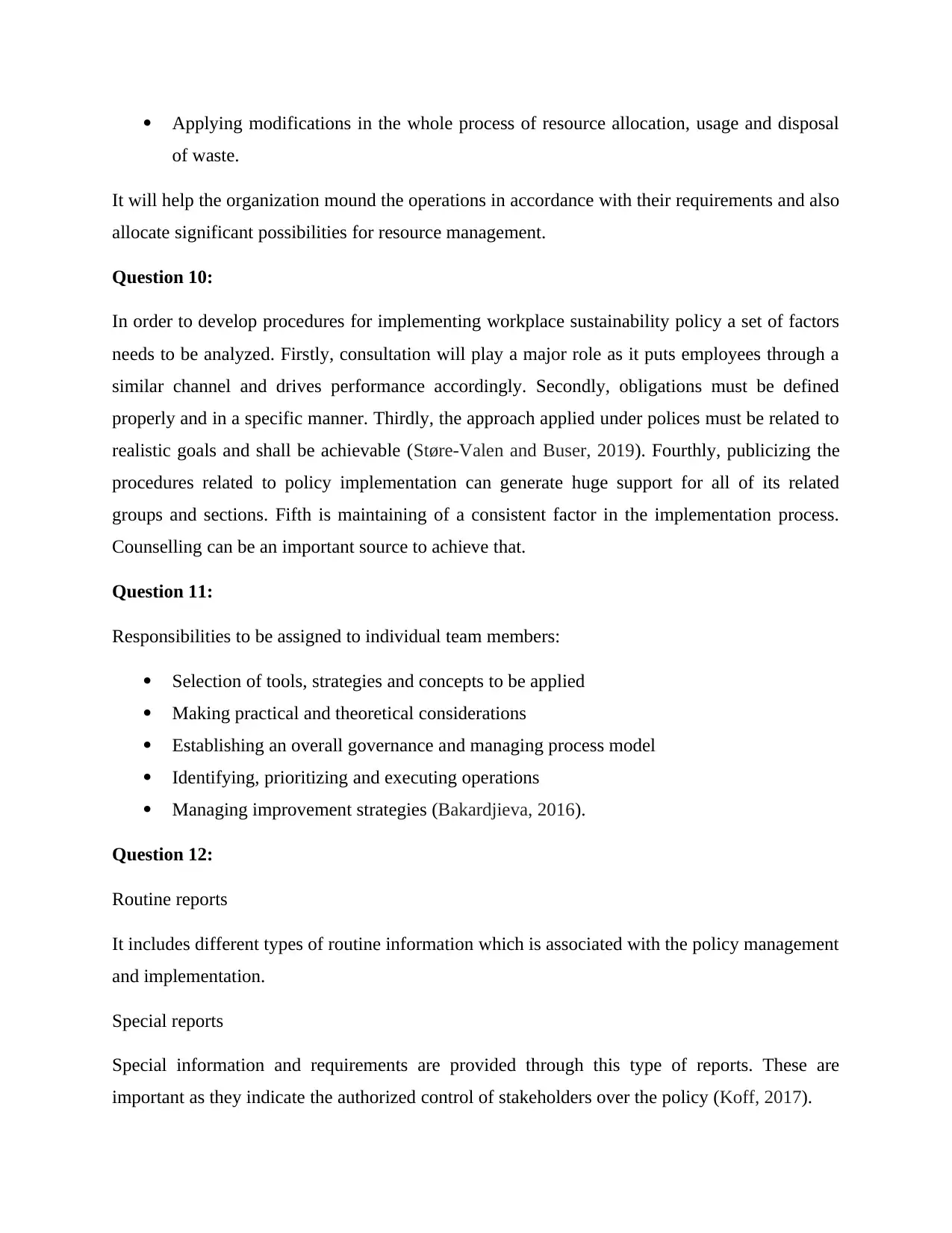
Applying modifications in the whole process of resource allocation, usage and disposal
of waste.
It will help the organization mound the operations in accordance with their requirements and also
allocate significant possibilities for resource management.
Question 10:
In order to develop procedures for implementing workplace sustainability policy a set of factors
needs to be analyzed. Firstly, consultation will play a major role as it puts employees through a
similar channel and drives performance accordingly. Secondly, obligations must be defined
properly and in a specific manner. Thirdly, the approach applied under polices must be related to
realistic goals and shall be achievable (Støre-Valen and Buser, 2019). Fourthly, publicizing the
procedures related to policy implementation can generate huge support for all of its related
groups and sections. Fifth is maintaining of a consistent factor in the implementation process.
Counselling can be an important source to achieve that.
Question 11:
Responsibilities to be assigned to individual team members:
Selection of tools, strategies and concepts to be applied
Making practical and theoretical considerations
Establishing an overall governance and managing process model
Identifying, prioritizing and executing operations
Managing improvement strategies (Bakardjieva, 2016).
Question 12:
Routine reports
It includes different types of routine information which is associated with the policy management
and implementation.
Special reports
Special information and requirements are provided through this type of reports. These are
important as they indicate the authorized control of stakeholders over the policy (Koff, 2017).
of waste.
It will help the organization mound the operations in accordance with their requirements and also
allocate significant possibilities for resource management.
Question 10:
In order to develop procedures for implementing workplace sustainability policy a set of factors
needs to be analyzed. Firstly, consultation will play a major role as it puts employees through a
similar channel and drives performance accordingly. Secondly, obligations must be defined
properly and in a specific manner. Thirdly, the approach applied under polices must be related to
realistic goals and shall be achievable (Støre-Valen and Buser, 2019). Fourthly, publicizing the
procedures related to policy implementation can generate huge support for all of its related
groups and sections. Fifth is maintaining of a consistent factor in the implementation process.
Counselling can be an important source to achieve that.
Question 11:
Responsibilities to be assigned to individual team members:
Selection of tools, strategies and concepts to be applied
Making practical and theoretical considerations
Establishing an overall governance and managing process model
Identifying, prioritizing and executing operations
Managing improvement strategies (Bakardjieva, 2016).
Question 12:
Routine reports
It includes different types of routine information which is associated with the policy management
and implementation.
Special reports
Special information and requirements are provided through this type of reports. These are
important as they indicate the authorized control of stakeholders over the policy (Koff, 2017).
⊘ This is a preview!⊘
Do you want full access?
Subscribe today to unlock all pages.

Trusted by 1+ million students worldwide
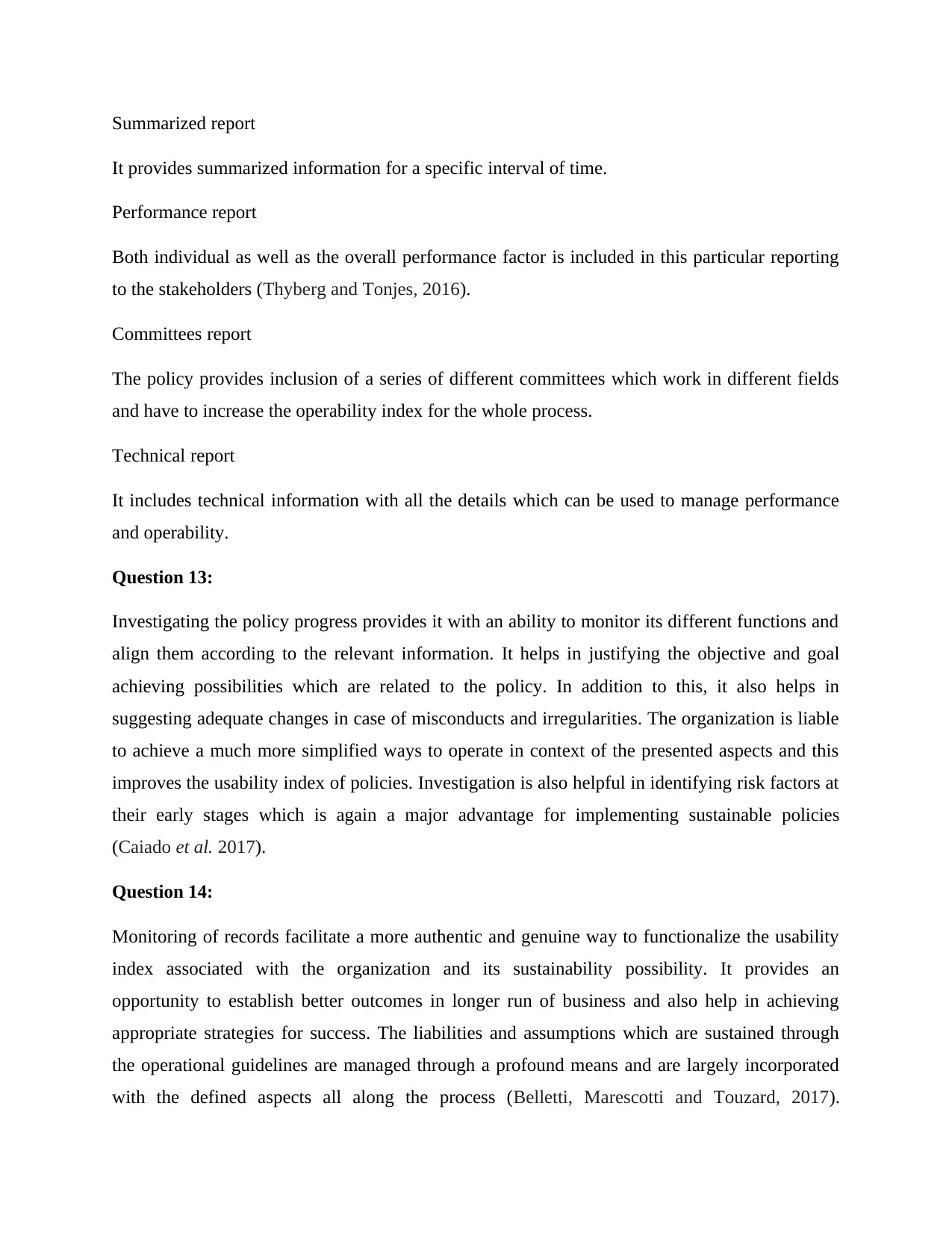
Summarized report
It provides summarized information for a specific interval of time.
Performance report
Both individual as well as the overall performance factor is included in this particular reporting
to the stakeholders (Thyberg and Tonjes, 2016).
Committees report
The policy provides inclusion of a series of different committees which work in different fields
and have to increase the operability index for the whole process.
Technical report
It includes technical information with all the details which can be used to manage performance
and operability.
Question 13:
Investigating the policy progress provides it with an ability to monitor its different functions and
align them according to the relevant information. It helps in justifying the objective and goal
achieving possibilities which are related to the policy. In addition to this, it also helps in
suggesting adequate changes in case of misconducts and irregularities. The organization is liable
to achieve a much more simplified ways to operate in context of the presented aspects and this
improves the usability index of policies. Investigation is also helpful in identifying risk factors at
their early stages which is again a major advantage for implementing sustainable policies
(Caiado et al. 2017).
Question 14:
Monitoring of records facilitate a more authentic and genuine way to functionalize the usability
index associated with the organization and its sustainability possibility. It provides an
opportunity to establish better outcomes in longer run of business and also help in achieving
appropriate strategies for success. The liabilities and assumptions which are sustained through
the operational guidelines are managed through a profound means and are largely incorporated
with the defined aspects all along the process (Belletti, Marescotti and Touzard, 2017).
It provides summarized information for a specific interval of time.
Performance report
Both individual as well as the overall performance factor is included in this particular reporting
to the stakeholders (Thyberg and Tonjes, 2016).
Committees report
The policy provides inclusion of a series of different committees which work in different fields
and have to increase the operability index for the whole process.
Technical report
It includes technical information with all the details which can be used to manage performance
and operability.
Question 13:
Investigating the policy progress provides it with an ability to monitor its different functions and
align them according to the relevant information. It helps in justifying the objective and goal
achieving possibilities which are related to the policy. In addition to this, it also helps in
suggesting adequate changes in case of misconducts and irregularities. The organization is liable
to achieve a much more simplified ways to operate in context of the presented aspects and this
improves the usability index of policies. Investigation is also helpful in identifying risk factors at
their early stages which is again a major advantage for implementing sustainable policies
(Caiado et al. 2017).
Question 14:
Monitoring of records facilitate a more authentic and genuine way to functionalize the usability
index associated with the organization and its sustainability possibility. It provides an
opportunity to establish better outcomes in longer run of business and also help in achieving
appropriate strategies for success. The liabilities and assumptions which are sustained through
the operational guidelines are managed through a profound means and are largely incorporated
with the defined aspects all along the process (Belletti, Marescotti and Touzard, 2017).
Paraphrase This Document
Need a fresh take? Get an instant paraphrase of this document with our AI Paraphraser
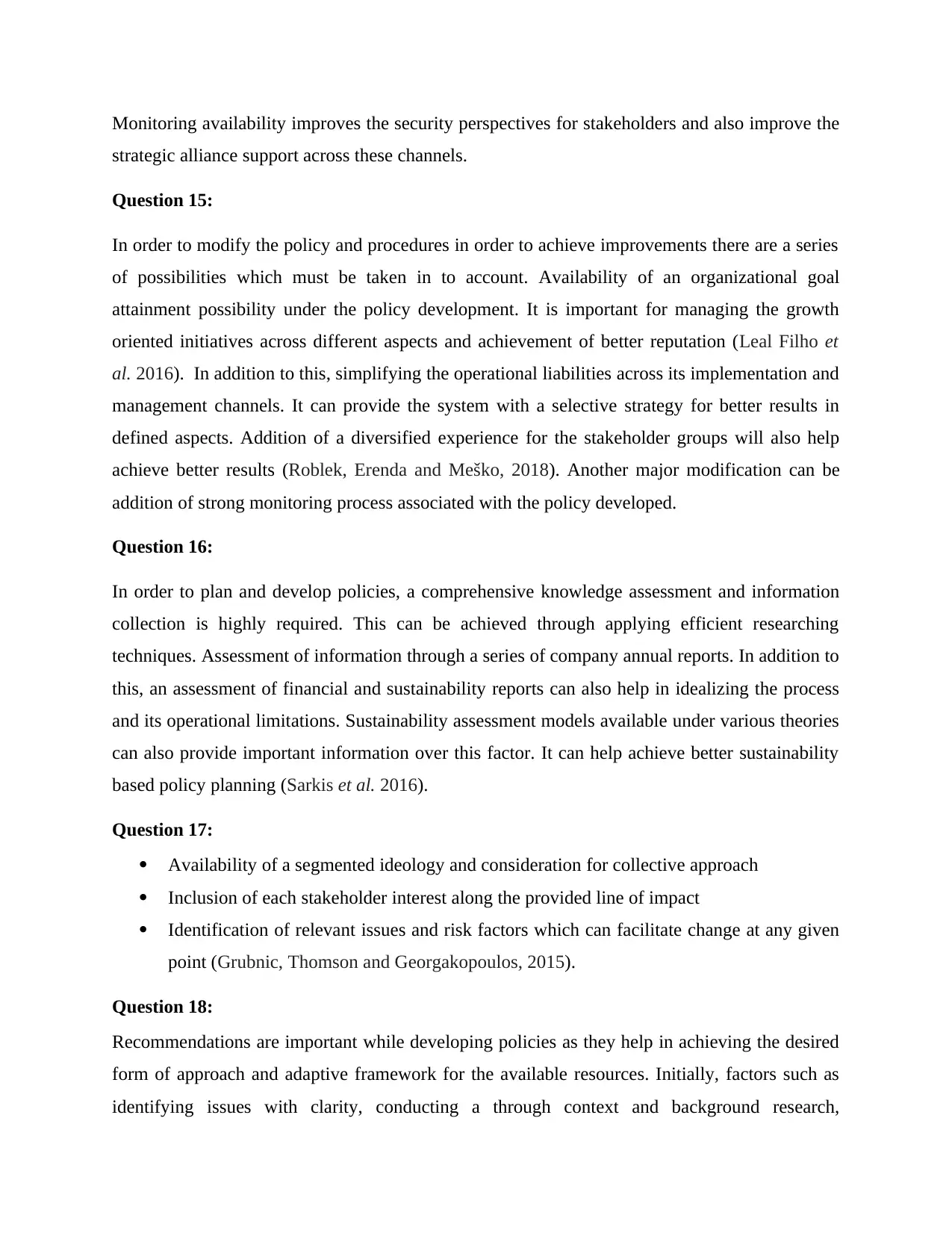
Monitoring availability improves the security perspectives for stakeholders and also improve the
strategic alliance support across these channels.
Question 15:
In order to modify the policy and procedures in order to achieve improvements there are a series
of possibilities which must be taken in to account. Availability of an organizational goal
attainment possibility under the policy development. It is important for managing the growth
oriented initiatives across different aspects and achievement of better reputation (Leal Filho et
al. 2016). In addition to this, simplifying the operational liabilities across its implementation and
management channels. It can provide the system with a selective strategy for better results in
defined aspects. Addition of a diversified experience for the stakeholder groups will also help
achieve better results (Roblek, Erenda and Meško, 2018). Another major modification can be
addition of strong monitoring process associated with the policy developed.
Question 16:
In order to plan and develop policies, a comprehensive knowledge assessment and information
collection is highly required. This can be achieved through applying efficient researching
techniques. Assessment of information through a series of company annual reports. In addition to
this, an assessment of financial and sustainability reports can also help in idealizing the process
and its operational limitations. Sustainability assessment models available under various theories
can also provide important information over this factor. It can help achieve better sustainability
based policy planning (Sarkis et al. 2016).
Question 17:
Availability of a segmented ideology and consideration for collective approach
Inclusion of each stakeholder interest along the provided line of impact
Identification of relevant issues and risk factors which can facilitate change at any given
point (Grubnic, Thomson and Georgakopoulos, 2015).
Question 18:
Recommendations are important while developing policies as they help in achieving the desired
form of approach and adaptive framework for the available resources. Initially, factors such as
identifying issues with clarity, conducting a through context and background research,
strategic alliance support across these channels.
Question 15:
In order to modify the policy and procedures in order to achieve improvements there are a series
of possibilities which must be taken in to account. Availability of an organizational goal
attainment possibility under the policy development. It is important for managing the growth
oriented initiatives across different aspects and achievement of better reputation (Leal Filho et
al. 2016). In addition to this, simplifying the operational liabilities across its implementation and
management channels. It can provide the system with a selective strategy for better results in
defined aspects. Addition of a diversified experience for the stakeholder groups will also help
achieve better results (Roblek, Erenda and Meško, 2018). Another major modification can be
addition of strong monitoring process associated with the policy developed.
Question 16:
In order to plan and develop policies, a comprehensive knowledge assessment and information
collection is highly required. This can be achieved through applying efficient researching
techniques. Assessment of information through a series of company annual reports. In addition to
this, an assessment of financial and sustainability reports can also help in idealizing the process
and its operational limitations. Sustainability assessment models available under various theories
can also provide important information over this factor. It can help achieve better sustainability
based policy planning (Sarkis et al. 2016).
Question 17:
Availability of a segmented ideology and consideration for collective approach
Inclusion of each stakeholder interest along the provided line of impact
Identification of relevant issues and risk factors which can facilitate change at any given
point (Grubnic, Thomson and Georgakopoulos, 2015).
Question 18:
Recommendations are important while developing policies as they help in achieving the desired
form of approach and adaptive framework for the available resources. Initially, factors such as
identifying issues with clarity, conducting a through context and background research,
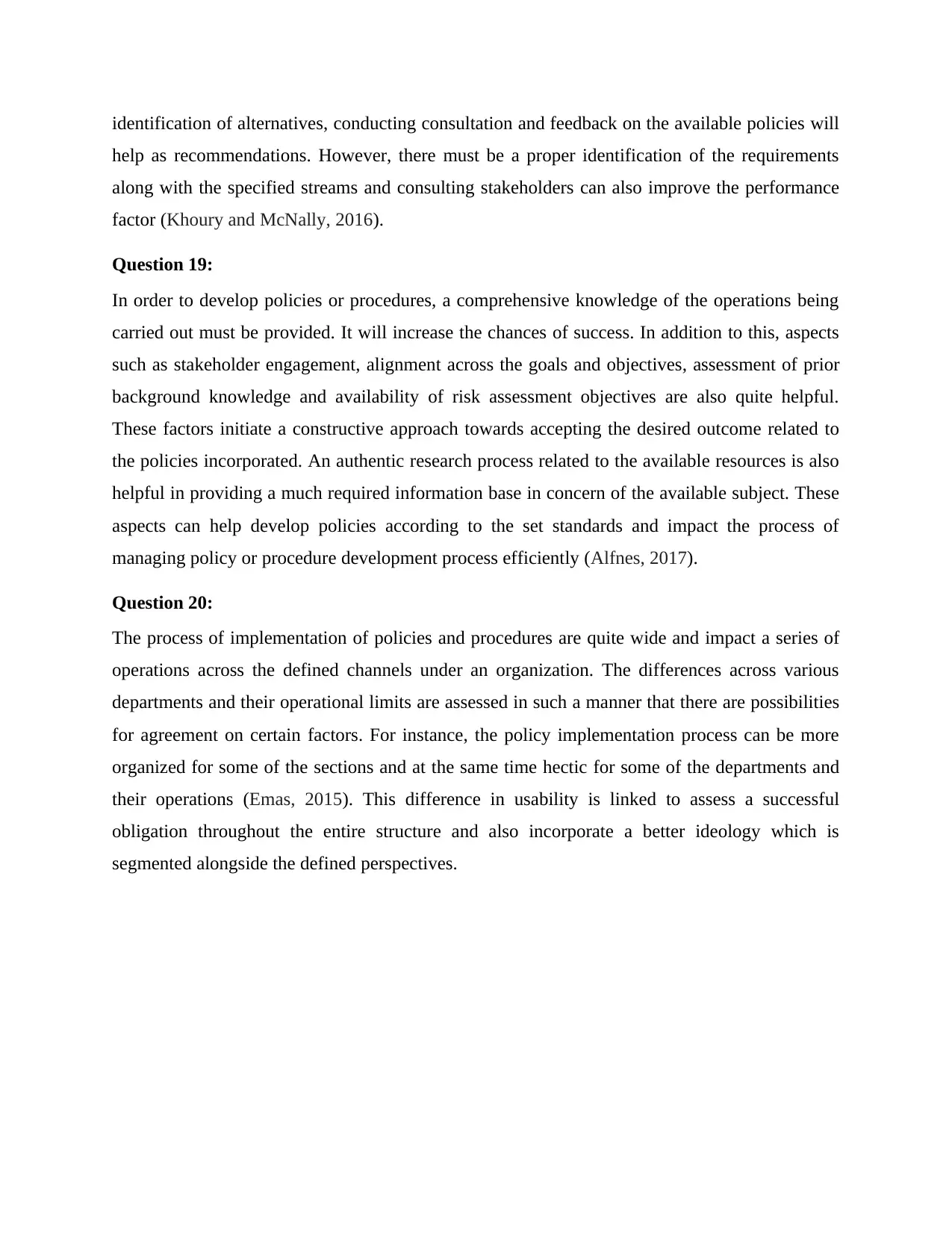
identification of alternatives, conducting consultation and feedback on the available policies will
help as recommendations. However, there must be a proper identification of the requirements
along with the specified streams and consulting stakeholders can also improve the performance
factor (Khoury and McNally, 2016).
Question 19:
In order to develop policies or procedures, a comprehensive knowledge of the operations being
carried out must be provided. It will increase the chances of success. In addition to this, aspects
such as stakeholder engagement, alignment across the goals and objectives, assessment of prior
background knowledge and availability of risk assessment objectives are also quite helpful.
These factors initiate a constructive approach towards accepting the desired outcome related to
the policies incorporated. An authentic research process related to the available resources is also
helpful in providing a much required information base in concern of the available subject. These
aspects can help develop policies according to the set standards and impact the process of
managing policy or procedure development process efficiently (Alfnes, 2017).
Question 20:
The process of implementation of policies and procedures are quite wide and impact a series of
operations across the defined channels under an organization. The differences across various
departments and their operational limits are assessed in such a manner that there are possibilities
for agreement on certain factors. For instance, the policy implementation process can be more
organized for some of the sections and at the same time hectic for some of the departments and
their operations (Emas, 2015). This difference in usability is linked to assess a successful
obligation throughout the entire structure and also incorporate a better ideology which is
segmented alongside the defined perspectives.
help as recommendations. However, there must be a proper identification of the requirements
along with the specified streams and consulting stakeholders can also improve the performance
factor (Khoury and McNally, 2016).
Question 19:
In order to develop policies or procedures, a comprehensive knowledge of the operations being
carried out must be provided. It will increase the chances of success. In addition to this, aspects
such as stakeholder engagement, alignment across the goals and objectives, assessment of prior
background knowledge and availability of risk assessment objectives are also quite helpful.
These factors initiate a constructive approach towards accepting the desired outcome related to
the policies incorporated. An authentic research process related to the available resources is also
helpful in providing a much required information base in concern of the available subject. These
aspects can help develop policies according to the set standards and impact the process of
managing policy or procedure development process efficiently (Alfnes, 2017).
Question 20:
The process of implementation of policies and procedures are quite wide and impact a series of
operations across the defined channels under an organization. The differences across various
departments and their operational limits are assessed in such a manner that there are possibilities
for agreement on certain factors. For instance, the policy implementation process can be more
organized for some of the sections and at the same time hectic for some of the departments and
their operations (Emas, 2015). This difference in usability is linked to assess a successful
obligation throughout the entire structure and also incorporate a better ideology which is
segmented alongside the defined perspectives.
⊘ This is a preview!⊘
Do you want full access?
Subscribe today to unlock all pages.

Trusted by 1+ million students worldwide
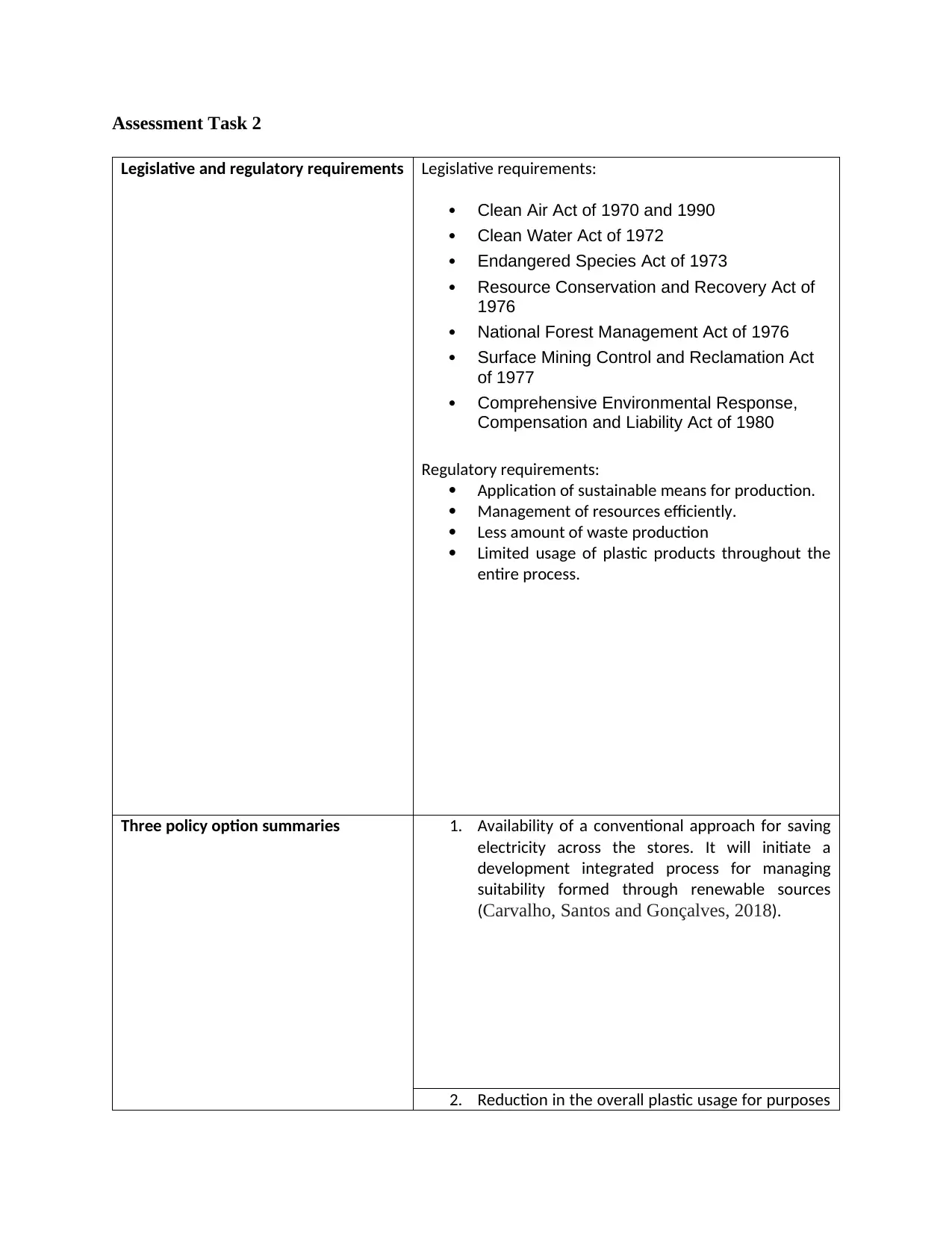
Assessment Task 2
Legislative and regulatory requirements Legislative requirements:
Clean Air Act of 1970 and 1990
Clean Water Act of 1972
Endangered Species Act of 1973
Resource Conservation and Recovery Act of
1976
National Forest Management Act of 1976
Surface Mining Control and Reclamation Act
of 1977
Comprehensive Environmental Response,
Compensation and Liability Act of 1980
Regulatory requirements:
Application of sustainable means for production.
Management of resources efficiently.
Less amount of waste production
Limited usage of plastic products throughout the
entire process.
Three policy option summaries 1. Availability of a conventional approach for saving
electricity across the stores. It will initiate a
development integrated process for managing
suitability formed through renewable sources
(Carvalho, Santos and Gonçalves, 2018).
2. Reduction in the overall plastic usage for purposes
Legislative and regulatory requirements Legislative requirements:
Clean Air Act of 1970 and 1990
Clean Water Act of 1972
Endangered Species Act of 1973
Resource Conservation and Recovery Act of
1976
National Forest Management Act of 1976
Surface Mining Control and Reclamation Act
of 1977
Comprehensive Environmental Response,
Compensation and Liability Act of 1980
Regulatory requirements:
Application of sustainable means for production.
Management of resources efficiently.
Less amount of waste production
Limited usage of plastic products throughout the
entire process.
Three policy option summaries 1. Availability of a conventional approach for saving
electricity across the stores. It will initiate a
development integrated process for managing
suitability formed through renewable sources
(Carvalho, Santos and Gonçalves, 2018).
2. Reduction in the overall plastic usage for purposes
Paraphrase This Document
Need a fresh take? Get an instant paraphrase of this document with our AI Paraphraser

of packing and delivery. It will make the
operations more sustainable and also comply with
the environmental regulations.
3. Limited stock renewable possibility to limit the
availability of significant amount of wastage. It will
limit the availability of resources and also its usage
in a boarder context.
Part C
1. Scope
Provide statement (as per below) about the application of this policy. Include matters that are out of
scope.
The availability of a conventional approaches for saving electricity can initiate a more sustainable
process which is important to development.
2. Policy statement
operations more sustainable and also comply with
the environmental regulations.
3. Limited stock renewable possibility to limit the
availability of significant amount of wastage. It will
limit the availability of resources and also its usage
in a boarder context.
Part C
1. Scope
Provide statement (as per below) about the application of this policy. Include matters that are out of
scope.
The availability of a conventional approaches for saving electricity can initiate a more sustainable
process which is important to development.
2. Policy statement
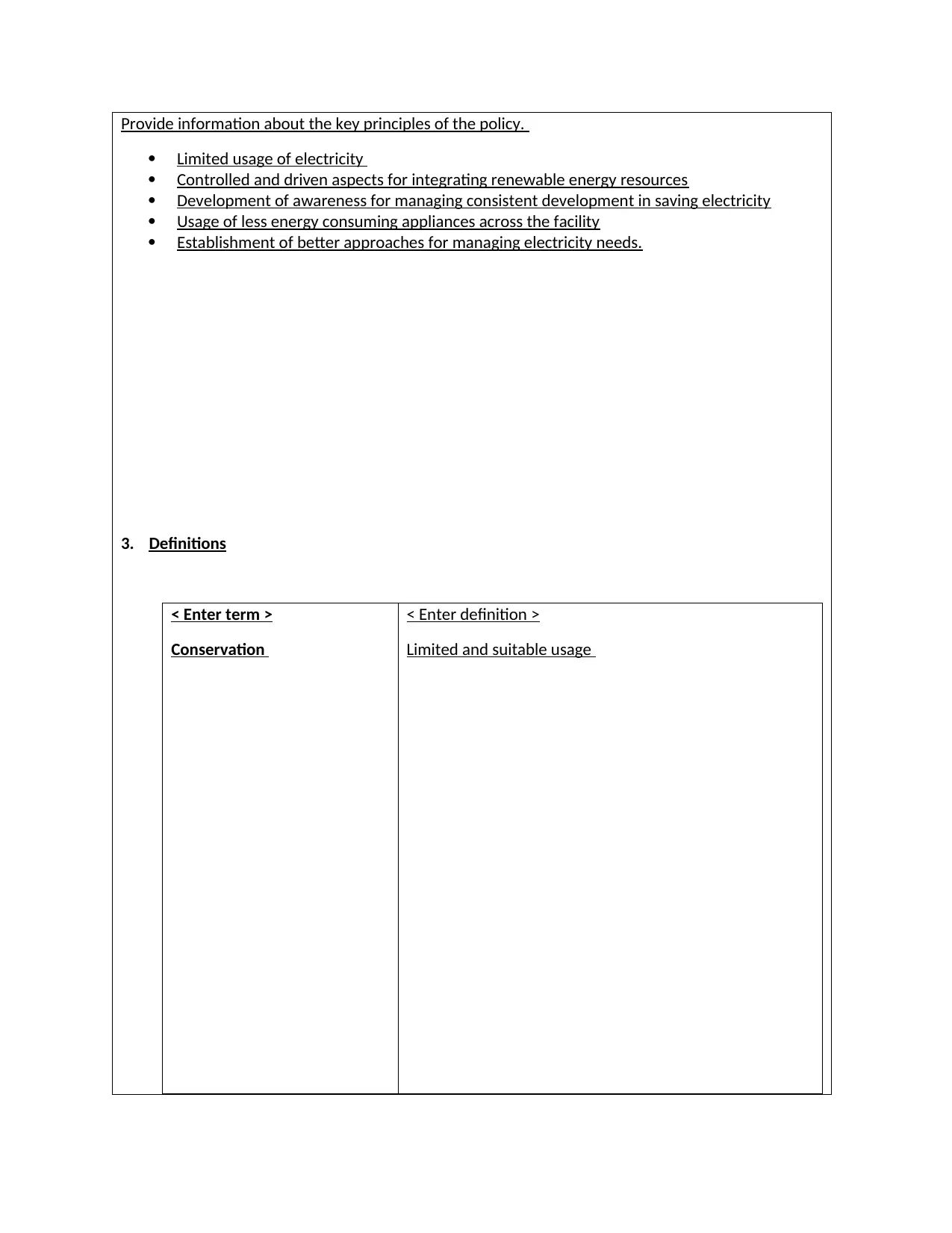
Provide information about the key principles of the policy.
Limited usage of electricity
Controlled and driven aspects for integrating renewable energy resources
Development of awareness for managing consistent development in saving electricity
Usage of less energy consuming appliances across the facility
Establishment of better approaches for managing electricity needs.
3. Definitions
< Enter term >
Conservation
< Enter definition >
Limited and suitable usage
Limited usage of electricity
Controlled and driven aspects for integrating renewable energy resources
Development of awareness for managing consistent development in saving electricity
Usage of less energy consuming appliances across the facility
Establishment of better approaches for managing electricity needs.
3. Definitions
< Enter term >
Conservation
< Enter definition >
Limited and suitable usage
⊘ This is a preview!⊘
Do you want full access?
Subscribe today to unlock all pages.

Trusted by 1+ million students worldwide
1 out of 18
Related Documents
Your All-in-One AI-Powered Toolkit for Academic Success.
+13062052269
info@desklib.com
Available 24*7 on WhatsApp / Email
![[object Object]](/_next/static/media/star-bottom.7253800d.svg)
Unlock your academic potential
Copyright © 2020–2025 A2Z Services. All Rights Reserved. Developed and managed by ZUCOL.





